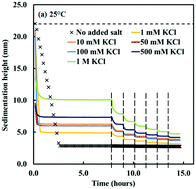Probing the stability of sterically stabilized polystyrene particles by centrifugal sedimentation†
Abstract
The stability and sedimentation behaviour of sterically stabilized temperature-sensitive colloidal particles has been investigated as a function of temperature and electrolyte concentration via an analytical centrifugation technique, the LUMiSizer®. The technique builds a steady particle bed at low centrifugal acceleration (∼145 × g), that is subsequently assessed in terms of network strength as the centrifugal field is increased up to ∼2325 × g. Stable particle dispersions produce a smooth constant profile irrespective of applied force, whilst aggregated dispersions show a stepwise compression profile with increasing force. The extent of bed compression, which correlates to the degree of particle aggregation, is more prominent at high electrolyte concentrations and temperatures. This is due to the dehydration of the steric stabilising layer and/or electrical double layer screening effects, which induce greater instability in the particles. Equilibrium compressive yield stress, Py(øeq), has been used to characterise the bed compression responses. Py(øeq) shows a power-law dependency on the particle volume fraction, with a denser bed produced at lower electrolyte concentrations at a given centrifugal force. Py(øeq) analysis has also assisted in describing the differences in particle structure as a function of thermal stability of the colloidal particles (i.e. with ‘sterically repulsive’ solvated polymeric shell or ‘attractive’ collapsed polymeric shell).


 Please wait while we load your content...
Please wait while we load your content...